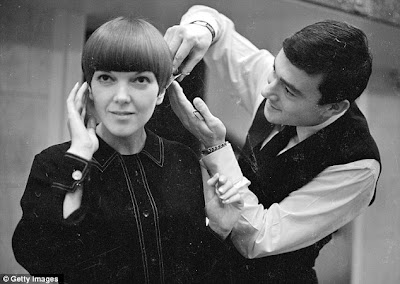I wanted everyone to retain the grace
of a child and not to have to become stilted, confined, ugly beings. So I created clothes which worked and moved
and allowed people to run, to jump, to leap, to retain this precious
freedom. Mary Quant 1966
 |
| Vidal Sassoon creating Mary Quant's signature bob |
Yesterday friend and colleague, Sue Bradley contacted me about her current exhibition in the window of 28 Milsom Street Bath - the old Culpepers shop. Sue was one of our designers on our Devon & Bath knitters' tour in 2010, inspiring everyone with her unique take on fashion, textiles and knitting. Her work is on display until after the Jubilee so if you're in Bath anytime before then check it out.
 |
| Sue Bradley's work at Milsom Place |
I've always been a fan of Sue's work and it got me thinking about how over the years I've been influenced by both Pop and OpArt.
 |
| More of Sue's work exhibited in Milsom Place |
Pop Art is the visual arts movement of the 1950s and '60s, which aimed to close the gap between
real life and art. Its images were taken from mass culture, artists duplicating
beer bottles, soup cans, comic strips, road signs, and similar objects in
paintings, collages, and sculptures. Others incorporated the objects themselves
into their paintings or sculptures, which often used the materials of modern
technology, such as plastic, polyurethane foam, and acrylic paint. The movement had a significant impact on
commercial, graphic, and fashion design as many of its originators were
commercial artists.
 |
| Peter Blake's Sgt Pepper Album cover |
London was
humming in the swinging sixties. I remember as a teenager busking with my guitar in the Portobello Road street market, where the
atmosphere was electric, a cosmopolitan circus of exotic foods, weird curios
and friendly people wearing beads, bells and amazing clothes, the whole belting
out the message that anything goes. With its cheap imports and ubiquitous scent
of patchouli, Carnaby Street also encouraged individual expression and became
the epicentre of the new youth culture.
Youth was empowered! The Beatles and other Liverpool bands
revolutionised popular music with the Mersey beat. In the States Bob Dylan rallied a generation
with his protest songs and the wild, inventive guitar playing of Jimi Hendrix
made him a style icon of the time. Pop festivals mushroomed and Woodstockdefined a generation of flower powered, pot-smoking, peace-lovers, who read
Aldous Huxley’s Doors of Perception and J.R. Tolkien’s Lord of the Rings.
Many young
people shunned western religion, the Buddhist search for nirvana had a wide
appeal. In London it was not unusual to
see the saffron robes usually worn by Tibetan monks, even if the wearer hailed
from no further east than Stepney. One
of my favourite cookery books was Edward Espe Brown's Tassajara Bread Book, a collection of deliciously scrumptious
breads, biscuits and cakes, edited by one of
the monks at the Californian Zen Buddhist monastery at Tassajara. I still bake their heavenly banana bread whenever time and ripe bananas permit.
Food
played a big part in Pop Art. In England David Hockney produced TyphooTea, one
of the earliest paintings to portray a brand-name commercial product. In the US
Rauschenberg painted cast bronzes of Ballantine beer cans, Claes Oldenburg
constructed garish, humorous plastic sculptures of hamburgers and other
fast-food items, whilst Andy Warhol immortalised the Campbell’s soup-can.
However, it was the
powerfully graphic images of Op Artists like Victor Vasarely and Bridget Riley
that intrigued me. Op Art got its name
from the optical tricks used to create the illusion of movement through spirals,
circles, stripes and squares. Some years
ago I was delighted to come across many of Vasarely’s magical paintings and
shimmering tapestries in a gallery which was once his home in Gordes, Provence.
 |
| Bridget Riley's Blaze 1 |
In Britain Bridget Riley’s dynamic and
dazzling canvasses focused attention on Op Art and influenced many aspects of
decorative art and fashion. Black and
white zebra stripes popped up everywhere.
Mary Quant invented the mini-skirt which, when worn with white Courégges
boots, created a striking space-age image every fashion-conscious young woman
craved - from Twiggy even to Germaine Greer.










Thanks for the nostalgia.
ReplyDeleteCarnaby St. Piccadilly Circus the British invasion
Mini skirts, clogs
I could go on.
I still have my bottle of pink catawba wine from Woodstock, empty of course.
I'm so envious, even Joni Mitchell didn't get to Woodstock although I know thousands did!
DeleteI miss my embroidered and patch worked bell-bottoms that my mother threw away while I was gone for a weekend. I feel like we're right back where we were before the 60's with ultra-conservative movements and rigorous conformance. We could use some peace and love right about now.
ReplyDeleteSo true Sandi!
DeleteThank you so much for sharing this post with your readers.
ReplyDelete